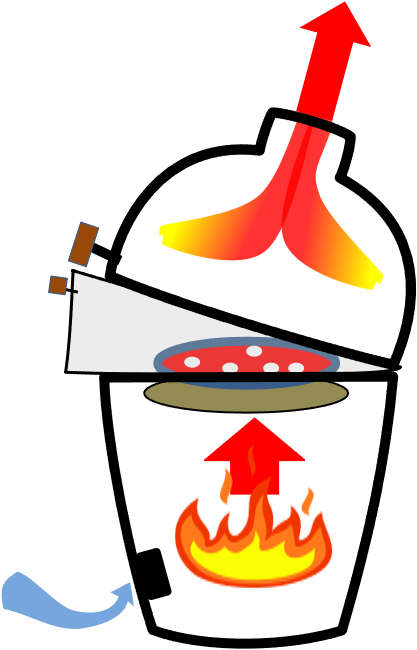Shut The Front Door - for the Best Pizza
An explanation of why the Pizza-Porta uses a door:
We invented the Pizza-Porta to make fantastic pizza in a kamado-style grill. The intention was to make real wood-fired pizza for our own parties. (We had a benchmark wood-fired oven in the neighborhood for comparison). Through trials and research, we found that the reason restaurants are able to create the light, crunchy crust is that they have high temperatures and great oven temperature management. The oven temperature is very consistent so the chef can make slight timing variations to accommodate different ingredients. Our final design uses a door and side vents to provide this capability.
Propping up the dome or adding some kind of pizza wedge with an opening does not improve the cooking chamber. Remember that the Pizza-Porta was engineered by an inventor on a mission to make the perfect pizza - not a marketing department adding a new accessory at a certain price point. Adding a door and vents made our lives a great deal more difficult - but made our pizzas significantly better. This is how we arrived at this design.
To start:
A kamado grill works by drawing air in the bottom vent to match the smoke/heat escaping through the chimney. This cycle increases the temperature as the incoming air is blowing a draft on the charcoal. As you have no doubt experienced, a wide open top and bottom vent will send the temperature around the thermometer dial.
First Attempt:
Our first design was a simple wedge shape with an opening and no door. We could monitor the pizza but that was the only benefit. The door opening was simply a huge vent. With that large of an opening, the BGE acted like an open fire without that “blast furnace” effect of the small top and bottom vents. We could only hit about 500ºF and the fire heated the pizza stone much more than the walls of the oven. We burned the bottom of numerous pizzas trying to get the top completely cooked. (and we burned the BGE handle)
We went back to studying how a wood-fired oven accomplishes temperature control without a door. It turns out that when the oven ceiling is a foot thick, there is a great deal of capacity to absorb heat. A fire burning wide open for hours may still not “fill up” the heat capacity of the oven walls. This “heat sink” is constantly absorbing energy from the fire temperatures and moderating it to perfect pizza cooking temperatures. (Pizza was actually invented to take advantage of the temperature characteristics of a heavy oven like this.) The fire is also to the side of the pizza so the intense heat (with a substantial amount of fuel) is focused on the ceiling, not on the bottom of the pizza stone. This oven design focuses radiant energy from the fire and the ceiling on the top of the pizza. The floor that the pizza is touching actually has a much lower temperature than the ceiling. It is truly an upside-down version of kamado pizza cooking!
The design of a kamado grill meant that we could rely on the ceramic to provide some temperature moderation, but we needed to manage the stone temperature within a certain range or it would burn the bottom of the pizza. We had to figure out how to manage the airflow through the oven to deliver temperatures within this cooking temperature range.
Our Next Design:
We realized that a door covering the opening would allow the bottom vent and the top vent to work together to maintain the blast furnace effect. With a door, we could use the regular vent adjustments to dial in the temperatures of the oven. This seemed to be a way to take advantage of the natural characteristics of a kamado grill.
After numerous trials with just a door, the pizzas were still not great. The bottoms continued to be overdone, and the crust was not puffing exactly as we wanted - as if it was cooking too slowly. Even though the dome thermometer read 650ºF, something was not working. We realized that too much heat was escaping out of the chimney to balance the temperature above and below the pizza. The door was an improvement, but we needed a way to retain heat in the dome.
Final Design:
The final discovery was to add side vents next to the door and cap off the top to cook. Moving the adjustable air vents below the top of the dome traps heat while maintaining airflow control. This combination was the sweet spot we were looking for and led us to our patented design for the Pizza-Porta. (probably the real reason the KJ and the BGE copies do not have a door and vents.)
The oven door allows the bottom and side vents to work together, throttling the amount of airflow going through the oven. Adding adjustable side vents allows the chimney vent to be closed completely trapping all the heat in the dome. The trapped heat soaks into the ceramic making it as hot as possible, balancing the temperature above and below the pizza. The pizza is surrounded by hot ceramic and reflective stainless surfaces so it cooks very evenly reducing the need to continually turn the pizza. A better-configured oven chamber cooks better pizza! We usually put a pizza in, check it once and if it is cooking unevenly we will turn it one time.
A side benefit to this setup is actually efficiency. If you are controlling the airflow and focusing all the heat, the fuel is used more efficiently. We generally get 3.5 to 4 hours of high-temperature pizza cooking from one load of charcoal. (Also, since the small door does not fully vent the fire, we don’t have a flashback when checking the pizza)
Thank you for reading - You can find our products here: Shop
If you want to read more details click: Here
For answers to frequently asked, questions try Here




